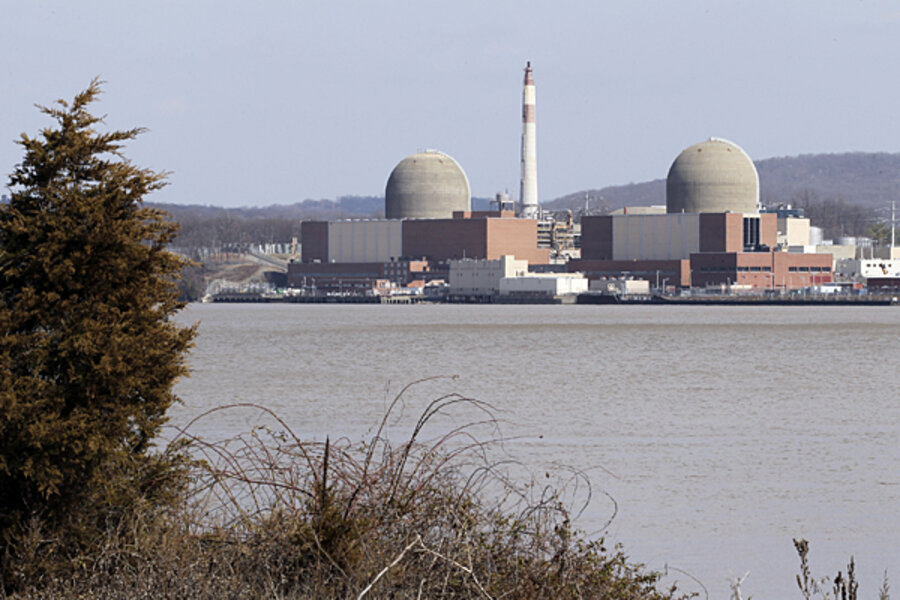Top priority in US earthquake study: nuclear power plant near New York City
Loading...
| New York
To New York Gov. Andrew Cuomo, the nuclear crisis in Japan is a warning bell for his own state.
Governor Cuomo has long been opposed to the Indian Point nuclear power plant, located on the Hudson River about 40 miles from New York City, calling it a “catastrophe waiting to happen.”
Now, in light of the Japanese situation and with evidence of a previously unknown fault line running near the plant, the US Nuclear Regulatory Commission (NRC) has agreed to make Indian Point one of its first priorities in an ongoing study of seismic risk.
On Tuesday, a contingent of New York state officials met with the NRC to express Cuomo’s concerns, especially with regard to the potential for an earthquake to damage the facility.
“When the data comes back in we want to make sure Indian Point is at or near the top of the list when we start looking at the data,” says Neil Sheehan, a spokesman for the NRC in King of Prussia, Pa., the regional center responsible for New York.
In Cuomo's battle against Indian Point, however, he's likely to have opposition from New York City Mayor Michael Bloomberg who notes that nearly one-third of the city's power comes from the facility.
“The mayor wants to learn from Japan but realizes that we can't simply close a plant that generates 32% of NYC's power without thinking about what sources will replace it,” writes Jason Post, a spokesman for Mayor Bloomberg, in an e-mail.
All in the family
While nuclear power maybe an important source of energy in New York and beyond, it is also under review in the US, particularly the 35 nuclear power plants that use the same basic design as the Fukushima plant in Japan. And Cuomo is one of those keeping pressure on regulators.
As New York’s attorney general, he asked federal regulators not to renew the license for Indian Point. Moreover, when Cuomo's father, Mario, was governor of New York, he opposed the Shoreham nuclear power plant on the grounds that it would be impossible to evacuate Long Island in case of a mishap. In 1989, the Long Island Lighting Co., which built the $6 billion plant, agreed to decommission it even before it produced any significant amount of electricity.
This time, the argument is likely to revolve around geology.
In 2004, the environmental group Riverkeeper wrote the NRC asking that the seismic hazard analysis for Indian Point be updated. The group based part of its request on geological studies done by Columbia University’s Lamont-Doherty Earth Observatory in Palisades, N.Y., which found evidence of two earthquakes of about 5.2 intensity in the area in 1737 and 1884.
The Lamont-Doherty study indicated quakes seemed to occur every 100 years, meaning another quake might be overdue. The NRC responded that it could find no evidence of this cycle, and since the quakes took place before modern instrumentation, it could not pinpoint the epicenter of the quakes.
Four years later, Lamont-Doherty published a new study that found another fault line that passes near Indian Point. Although that fault line may not indicate an earthquake is imminent, the last 300 years have indicated there has been some motion, says John Armbruster, one of the authors of the report and a seismologist.
“Since Indian Point was designed in the 1960s, our knowledge of earthquakes has improved and computers have completely revolutionized engineering,” says Armbruster. “To do a restudy of the possible affects of earthquakes on Indian Point now will be very much different and very much improved compared to what could be done in the 1960s.”
Jerry Nappi, a spokesman for Indian Point, says the area around Indian Point is not susceptible to the type of earthquake that occurred in Japan or a tsunami. In addition, he says Indian Point was built to withstand a 6.0 quake.
“Nevertheless, in the next 30 days, we along with other nuclear utilities will look at issues such as earthquakes, tsunamis, flooding, and other natural disasters to see how they could possibly affect us and make sure we meet the worst possible scenarios.”
The future of nuclear
The brouhaha over Indian Point comes at a time when the construction of new nuclear power plants in the US has just about stopped, says Robert Bryce, a senior fellow at the Manhattan Institute and author of "Power Hungry.”
“They have been pretty much priced out of the market by cheap natural gas prices,” says Mr. Bryce. “In the wake of Fukushima, we will see the global expansion of nuclear energy slowed, but it will not stop because the physics of nuclear energy are so compelling the global demand for electricity is so strong.”
Recently, the International Energy Agency estimated the global demand for energy will increase 80 percent by 2035.
“In my view that demand assures that in spite of what happened in Fukushima, it will be the go-to source,” says Bryce.





